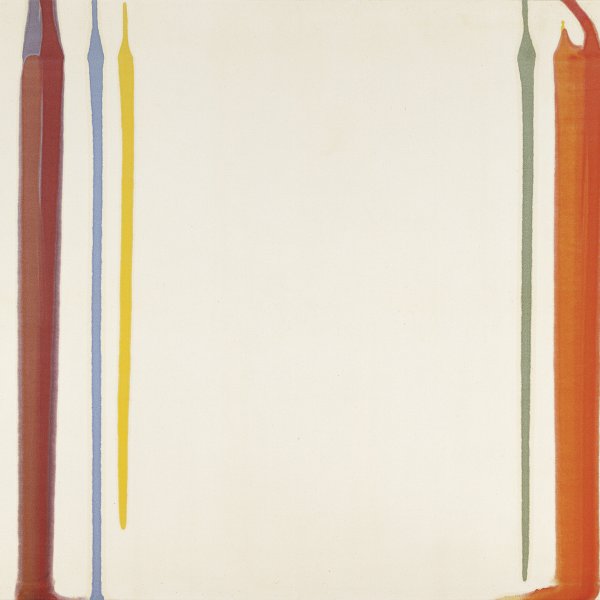Morris Louis
Baltimore, 1912-Washington, 1962
Morris Louis belonged to what the critic Clement Greenberg called “Post-Painterly Abstraction, ” which followed the pioneers of the School of New York.
Born Morris Louis Bernstein, he studied at the Maryland Institute of Fine and Applied Arts in Baltimore from 1927 to 1932, the year the Works Progress Administration commissioned him to paint a mural at a state school in his city of birth. In this mural and those he subsequently executed in Washington and New York, Louis addressed themes related to the world of work in a style that recalled the oeuvre of Max Beckmann. While living in New York from 1936 to 1940, Louis changed his name, came into contact with Arshile Gorky and David Alfaro Siqueiros, and took part in the experimental workshops organised by Siqueiros. There he became acquainted with the use of enamel paints. By the time he returned to Baltimore in 1940, his works had Surrealist reminiscences and in 1947, the year he married and went to live in Washington, he began to use synthetic resin, which enabled him to achieve colours with a luminous transparency.
At the Washington Workshop Center of Arts, where Louis worked as a teacher, he came into contact with Kenneth Noland. Through Noland he met Greenberg and together they visited numerous New York galleries, keenly viewing the works of American artists, particularly Jackson Pollock. A turning point in Louis’s painting came in 1953 when he visited the workshop of Helen Frankentaler and was fascinated by a canvas without a stretcher, placed on the floor, to which she had applied greatly diluted paint. Back in Washington, Louis and Noland experimented with various painting techniques and their application. In 1954 he started on the series of Veils, canvases in which he achieved the interpenetration of colours in the manner of watercolour by using finely applied patches of acrylic paint. Starting in 1960 he produced his series of Florals, Columns and Unfurleds, consisting of parallel strips of colour framing the blank central area of the canvas. In his series of Stripes, executed in 1961–62, the bands of colour float on a neutral background.
After his death, Greenberg personally dealt with cataloguing his paintings. He is considered to be one of the forerunners of Minimalism.
Born Morris Louis Bernstein, he studied at the Maryland Institute of Fine and Applied Arts in Baltimore from 1927 to 1932, the year the Works Progress Administration commissioned him to paint a mural at a state school in his city of birth. In this mural and those he subsequently executed in Washington and New York, Louis addressed themes related to the world of work in a style that recalled the oeuvre of Max Beckmann. While living in New York from 1936 to 1940, Louis changed his name, came into contact with Arshile Gorky and David Alfaro Siqueiros, and took part in the experimental workshops organised by Siqueiros. There he became acquainted with the use of enamel paints. By the time he returned to Baltimore in 1940, his works had Surrealist reminiscences and in 1947, the year he married and went to live in Washington, he began to use synthetic resin, which enabled him to achieve colours with a luminous transparency.
At the Washington Workshop Center of Arts, where Louis worked as a teacher, he came into contact with Kenneth Noland. Through Noland he met Greenberg and together they visited numerous New York galleries, keenly viewing the works of American artists, particularly Jackson Pollock. A turning point in Louis’s painting came in 1953 when he visited the workshop of Helen Frankentaler and was fascinated by a canvas without a stretcher, placed on the floor, to which she had applied greatly diluted paint. Back in Washington, Louis and Noland experimented with various painting techniques and their application. In 1954 he started on the series of Veils, canvases in which he achieved the interpenetration of colours in the manner of watercolour by using finely applied patches of acrylic paint. Starting in 1960 he produced his series of Florals, Columns and Unfurleds, consisting of parallel strips of colour framing the blank central area of the canvas. In his series of Stripes, executed in 1961–62, the bands of colour float on a neutral background.
After his death, Greenberg personally dealt with cataloguing his paintings. He is considered to be one of the forerunners of Minimalism.




